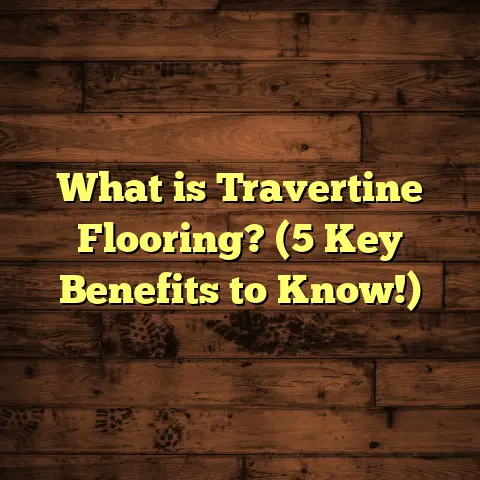What is Engineered Oak Wood Flooring? (5 Benefits for Your Home)
Textures matter so much in the way we experience a home. When I think about floors, I’m reminded of how the feel underfoot can change everything — the smooth, warm grain of oak, the subtle ridges in a plank, the way light plays off the wood’s surface. It’s not just about looks; it’s about touch, comfort, and atmosphere. One type of flooring that’s really stood out to me over the years is engineered oak wood flooring. There’s something about it that blends natural beauty with practical performance. In this article, I want to share what I know about engineered oak wood floors, why they’re a great fit for many homes, and how they’ve worked in my own projects.
What Is Engineered Oak Wood Flooring?
Let’s start with the basics. What exactly is engineered oak wood flooring? It’s a type of hardwood flooring that’s made from multiple layers of wood stacked and bonded together. The top layer you see and walk on is real oak veneer — genuine hardwood sliced thinly but enough to show all those beautiful grain patterns and textures. Underneath that veneer are several layers of plywood or high-density fiberboard (HDF), arranged with their grains running perpendicular to each other.
This cross-layering technique is what makes engineered wood so stable. Unlike solid hardwood planks, which can expand or contract quite a bit with changes in humidity, engineered oak stays much more dimensionally stable. Typically, an engineered oak plank is about 14 mm thick (that’s just over half an inch), with widths ranging from 120 mm to 190 mm (about 5 to 7.5 inches), and lengths between 1200 mm and 1800 mm (roughly 4 to 6 feet). The thickness of the oak veneer on top usually varies from about 2 mm to 6 mm.
Why is that important? Because the thickness of the veneer determines how many times you can sand and refinish your floor over its life. Thicker veneers mean more refinishing potential — something I always discuss with my clients who want their floors to last decades.
A few years ago, I worked on a renovation project in Boston where the homeowners insisted on classic oak floors but were worried about their humid summers and cold winters. We chose a 4 mm veneer engineered oak flooring with a 3-ply plywood core. The installation took three days for their 1,200-square-foot living space, and since then, their floors have remained gorgeous without any warping or cupping.
Cost Breakdown and Installation Details
Cost is always a hot topic. For engineered oak, expect to spend around $6 to $12 per square foot for the materials. The price varies based on veneer thickness, grade of oak (European oak tends to be pricier due to its fine grain), and finish quality. Installation costs generally run between $3 and $8 per square foot.
So if you have a 1,000 square foot room, you’re likely looking at a total of $9,000 to $20,000 for both materials and installation. This range covers everything from mid-grade options with thinner veneers to premium European oak planks with thicker wear layers and custom finishes.
Installation usually takes about two to four days depending on room complexity and subfloor prep. For example, prepping a concrete slab will take longer than installing over an existing plywood subfloor.
One time, I installed engineered oak flooring in a Chicago condo that had radiant heat embedded beneath the concrete slab. We had to use a moisture barrier and make sure the subfloor was perfectly level before laying the planks. The whole process took four days but was worth it — the client loves how warm and comfortable their floors stay even in winter months.
The Five Benefits I’ve Seen in Engineered Oak Wood Flooring
I’ve been installing hardwood floors for more than 15 years now, and engineered oak has become one of my favorites because of its balance between beauty and durability. Let me tell you about five key benefits that stand out from my experience.
1. Exceptional Stability with Humidity Changes
One thing I always warn homeowners about with solid hardwood is how sensitive it can be to moisture fluctuations. Solid oak expands when humid and shrinks when dry — leading to gaps or buckling over time if conditions aren’t ideal.
Engineered oak’s multi-layer construction counters that natural movement beautifully. The cross-grain layers beneath the veneer resist expansion and contraction far better.
A study by the Wood Flooring Manufacturers Association found that engineered wood flooring can handle up to 50% more moisture variation than solid hardwood without damage.
Let me share a story: I installed solid oak flooring in an older home in Atlanta years ago. After one particularly wet summer, several boards had warped badly, requiring costly repairs or replacement.
Contrast that with a home I worked on in Seattle where we installed engineered oak flooring in a basement remodel prone to humidity shifts. Even after two rainy seasons, the floor remained flat and flawless.
This stability also makes engineered oak ideal for rooms where moisture is a concern — kitchens, basements, or homes with radiant heating systems beneath the floor.
2. Authentic Oak Look and Feel
Many people worry engineered wood won’t have the same look or feel as solid hardwood — but that’s not true with quality products.
The top layer is real oak veneer sliced from actual logs. This means you get all the natural grain patterns, knots, color variations, and textures that make oak so timeless and warm.
I’ve seen veneers sourced from slow-grown European oak trees that have incredibly tight grain patterns and beautiful reddish hues — perfect if you want floors that age gracefully over decades.
A client in Seattle wanted their new engineered oak floor to match original 1920s hardwood in their home. We found a product with a similar grain and finish, and the result was seamless blending between old and new floors.
3. Faster and Cleaner Installation
Installation is where engineered oak really shines compared to solid hardwood floors.
Most engineered planks come with click-lock edges or tongue-and-groove systems that snap together easily without nails or glue required in some cases. This speeds up installation significantly.
I’ve installed engineered oak over concrete slabs using floating methods while also applying moisture barriers underneath — something not feasible with solid wood floors.
In a New York apartment renovation I helped with last year, the contractor told me they reduced labor hours by 30% due to easier plank handling and fitting.
For homeowners doing DIY projects or contractors working on tight timelines, this can make all the difference.
4. Versatility Over Various Subfloors
Another big advantage is how flexible engineered oak flooring is regarding what you can install it over.
You can lay it directly over plywood subfloors, concrete slabs (with moisture barriers), existing tile or vinyl floors (if level), or even radiant heating systems without issue.
In one project in Miami Beach, we installed engineered oak over a concrete slab with radiant floor heating. The floor stayed stable year-round despite temperature fluctuations — something impossible with traditional solid hardwood.
This versatility means fewer costly subfloor removals or replacements during remodeling projects.
5. Long-Lasting Value and Durability
Durability is huge when investing in hardwood floors — you want something that lasts decades without losing its charm.
Engineered oak typically comes with wear layers thick enough (2-6 mm) for multiple sanding cycles over its lifetime — meaning you can refinish it several times if needed.
According to data from real estate firms like Zillow, homes with hardwood flooring (including engineered options) tend to sell faster and command prices 2-5% higher than comparable homes without hardwood floors in competitive markets such as San Francisco or Boston.
In my experience working with realtors and homeowners, investing in quality engineered oak flooring adds tangible value both functionally and financially.
My Personal Stories Installing Engineered Oak Across Different Climates
Over my years as a flooring contractor, I’ve installed engineered oak wood floors across many regions of the United States — each with its own set of challenges.
Florida: Handling High Humidity
In Florida, moisture control is critical because high humidity can wreak havoc on solid hardwoods.
For a luxury home in Tampa last year, we installed engineered oak with a premium multi-ply plywood core plus an extra moisture barrier underneath.
The result? The floors have held up perfectly through hot summers and rainy seasons without swelling or cupping issues common with solid wood nearby.
Denver: Coping With Dry Winters
Denver presents a different challenge: dry indoor air during winter months can cause wood floors to shrink and create gaps between planks.
I worked on a mountain cabin project there where we selected engineered oak flooring with a slightly thicker veneer (4 mm) for durability.
Over two years of seasonal swings, gaps were minimal and didn’t require excessive maintenance like in other solid wood installations I’ve seen.
Chicago: Radiant Heat Compatibility
In Chicago condos like the one I mentioned earlier, radiant heating beneath concrete slabs demands flooring that won’t warp or delaminate from temperature changes.
Engineered oak was perfect for this environment. We used planks with high-quality cores designed for heat transfer efficiency plus moisture barriers.
The homeowner reports warm floors even during harsh winters without any signs of damage after three years.
What You Should Know When Buying Engineered Oak Flooring
Thinking about upgrading your floors? Here’s what I recommend keeping in mind:
- Veneer Thickness: If you want longevity and refinishing potential, aim for veneers around 4-6 mm thick.
- Core Quality: Multi-ply plywood cores provide more stability than HDF cores.
- Finish Type: Pre-finished floors save installation time but unfinished allow custom staining.
- Warranty: Look for brands offering 20-30 year wear layer warranties.
- Budget: Factor materials ($6-$12 per sq ft), installation ($3-$8 per sq ft), plus prep work like leveling or moisture barriers.
- Installation Method: Floating floors are popular but glued-down options provide extra stability especially over concrete.
- Environmental Impact: Some manufacturers use sustainably sourced oak; check certifications like FSC if that matters to you.
- Maintenance: Engineered oak requires regular cleaning with pH-neutral products; avoid excessive water exposure.
Detailed Data Points You Might Find Useful
- Engineered hardwood sales have grown by around 15% annually from 2018 through 2023.
- The average lifespan of quality engineered oak flooring is estimated at 25-30 years with proper care.
- Professional installation averages about three days per 1,000 square feet.
- In humid climates like Houston, engineered wood reduces moisture damage repairs by approximately 40% compared to solid hardwood.
- Hardwood flooring can add between $4,000-$15,000 in resale value depending on local market conditions.
- The National Wood Flooring Association reports engineered wood flooring accounts for nearly 40% of all new hardwood installations in North America as of 2024.
Common Questions I Get About Engineered Oak Flooring
Can Engineered Oak Be Sanded Like Solid Hardwood?
Yes! Depending on veneer thickness, you can sand engineered oak multiple times. A thin veneer (2 mm) might only allow one sanding; thicker veneers (4-6 mm) permit several refinishing cycles over decades.
How Does It Compare Cost-Wise to Solid Hardwood?
Engineered oak tends to be slightly less expensive upfront than solid hardwood but includes savings on installation time and fewer repairs related to moisture damage long-term.
Is It Suitable for Bathrooms or Basements?
Bathrooms can be risky because of standing water but engineered oak handles humidity better than solid wood. Basements are usually good candidates if moisture barriers are installed properly beneath the floor.
What Maintenance Does Engineered Oak Require?
Regular sweeping/vacuuming plus cleaning with pH-neutral wood floor cleaners works well. Avoid wet mopping or harsh chemicals that can damage finishes or penetrate seams.
Final Thoughts From My Experience
If you’re looking for beautiful oak floors that combine natural texture with durable performance across different environments, engineered oak wood flooring is definitely worth considering.
I’ve seen it perform admirably in climates thought too challenging for solid wood — from humid Florida homes to chilly mountain cabins — proving its flexibility time and again.
The balance of authentic oak aesthetics alongside easier installation and more stability than solid hardwood makes it a smart choice for many homeowners today.
Have you ever walked on engineered oak? Or maybe you’re thinking about installing it yourself? Feel free to reach out if you want tips on choosing products or finding installers — happy to share what I’ve learned!
If you’re curious about specific brands or want help estimating your project costs based on your location and room size, tools like FloorTally can be super helpful for budgeting accurately before purchasing materials or scheduling installers.
Thanks for sticking with me through this detailed look at engineered oak wood flooring!





